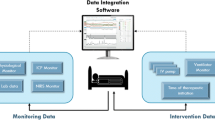Abstract
Objective
Physiological monitoring is a requisite for optimal care to ensure that the condition of a patient is maintained within safe levels. Monitoring can be jeopardized by the inability of a clinician to recognize important changes in the visual display of data throughout the duration of the monitoring task. We hypothesized that the addition of a visual cue imparting contextual information to a physiological display would improve the detection ability and response time of a clinician to a change in a patient variable.
Methods
Contextual information based on trend information was added to a physiological display in the form of a visual cue. Following IRB approval, the resulting enhanced display was evaluated by 22 anesthesiologists in a simulated operating room, through the observation of six simulated scenarios using a standard anesthesia display and the enhanced display. Demographic information, response time, accuracy of detection, and usability data were collected.
Results
The enhanced display reduced the detection time to a change in the simulated scenarios by 14.4 s (95% CI: −26.4 to −2.38), and reduced the expected number of missed events per scenario by 0.23 (95% CI: −0.439 to −0.0203), based on the repeated measures analysis (Poisson model).
Conclusions
The data collected and analyzed in this study supports the addition of a visual cue to future physiological monitors. The graphic representation and the context relevant information that it transmits appears to aid clinicians. While the results indicate that enhanced visualization of context relevant information can lead to a significant improvement in event recognition and identification, further evaluation in clinical settings is required.
Similar content being viewed by others
References
Weinger MB. Vigilance, boredom, and sleepiness. J Clin Monit Comput. 1999;15:549–52.
Weinger MB, Englund CE. Ergonomic and human factors affecting anesthetic vigilance and monitoring performance in the operating room environment. Anesthesiology. 1990;73:995–1021.
Simons DJ, Ambinder MS. Change blindness: theory and consequences. Curr Dir Psychol Sci. 2005;14:44–8.
Gaba DM. Human performance issues in anaesthesia patient safety. Probl Anesth. 1991;5:329–50.
Drews FA, Westenskow DR. Display design in anesthesia. Hum Factors. 2006;48:59–71.
Rensink RA, O’Regan JK, Clark JJ. To see or not to see: the need for attention to perceive changes in scenes. Psychol Sci. 1997;8:368–73.
Hitchcock EM, Dember WN, Warm JS, Moroney BW, See JE. Effects of cueing and knowledge results on workload and boredom in sustained attention. Hum Factors. 1999;41:365–72.
Warm JS, Dember WN, Hancock PA. Automation and human performance: theory and applications. In: Parasuraman R, Mouloua M, editors. Vigilance and workload in automated systems. Hillsdale, NJ: Erlbaum; 1996. p. 183–200.
Yang P, Dumont G, Ansermino JM. Adaptive change detection in heart rate monitoring in anesthetized children. IEEE Trans Biomed Eng. 2006;53:2211–9.
Ansermino JM, Daniels JP, Hewgill RT, Lim J, Yang P, Brouse CJ, et al. An evaluation of a novel software tool for detecting changes in physiological monitoring. Anesth Analg. 2009;108:873–80.
Spinuzzi C. The methodology of participatory design. Tech Commun. 2005;52:163–74.
Lewis J. IBM computer usability satisfaction questionnaires. Int J Hum Comput Interact. 1995;7:57–78.
Stanton NA, Salmon PM, Walker GH, Baber C, Jenkins DP. Human factors methods: a practical guide for engineering and design. Aldershot, Hampshire: Ashgate Publishing Limited; 2005.
Ford S, Daniels J, Lim J, Koval V, Dumont GA, Schwarz SK, et al. A novel vibrotactile display to improve the performance of anesthesiologists in a simulated critical incident. Anesth Analg. 2008;106:1182–8.
Laird NM, Ware JH. Random-effects models for longitudinal data. Biometrics. 1982;38:963–74.
Zeger SL, Liang KY. Longitudinal data analysis for discrete and continuous outcomes. Biometrics. 1986;42:121–30.
Sigurdson K, Ayas NT. The public health and safety consequences of sleep disorders. Can J Physiol Pharmacol. 2007;85:179–83.
Fayyad U, Grinstein GG, Wierse A. Information visualization in data mining and knowledge discovery. San Francisco, CA: Morgan Kaufmann Publishers Inc.; 2001.
Cooper JB, Newbower RS, Kitz RJ. An analysis of major errors and equipment failures in anesthesia management: considerations for prevention and detection. Anesthesiology. 1984;60:34–42.
Tinker JH, Dull DL, Caplan RA, Ward RJ, Cheney FW. Role of monitoring devices in prevention of anesthetic mishaps: a closed claims analysis. Anesthesiology. 1989;71:541–6.
Jungk A, Thull B, Hoeft A, Rau G. Evaluation of two new ecological approaches for the anesthesia workplace. J Clin Monit Comput. 2000;16:243–58.
Burns CM, Hajdukiewicz JR. Ecological interface design. Boca Raton, FL: CRC Press; 2004.
Watson MO, Sanderson PM. Designing for attention with sound: challenges and extensions to ecological interface design. Hum Factors. 2007;49:331–46.
McIntyre J. Ergonomics: anaesthetists’ use of auditory alarms in the operating room. Int J Clin Monit Comput. 1985;2:47–55.
Finley GA, Cohen AJ. Perceived urgency and the anaesthetist: responses to common operating room monitor alarms. Can J Anaesth. 1991;38:958–64.
Birmingham E, Ford S, Lim J, Ansermino JM. How often do anesthesiologists really check their monitors? Can J Anaesth. 2007;54:44522.
Matthews G, Davies DR, Westerman SJ, Stammers RB. Human performance: cognition, stress and individual differences. Hove, Sussex: Psychology Press; 2000.
Simons DJ, Rensink RA. Change blindness: past, present, and future. Trends Cogn Sci. 2005;9:16–20.
Breslow MJ, Rosenfeld BA, Doerfler M, Burke G, Yates G, Stone GJ, et al. Effect of a multiple-site intensive care unit telemedicine program on clinical and economic outcomes: an alternative paradigm for intensivist staffing. Crit Care Med. 2004;32:31–8.
Acknowledgements
Completion of this work was supported by the Department of Anesthesiology, Pharmacology & Therapeutics at the University of British Columbia (UBC), Vancouver, British Columbia, Canada. A special thanks to Ping Yang (PhD, Department of Electrical & Computer Engineering, University of British Columbia, Vancouver, British Columbia, Canada) for providing the technical guidance of her past work that was needed to fully realize this study.
Author information
Authors and Affiliations
Corresponding author
Additional information
Presented at the Society for Technology in Anesthesia Annual Meeting, San Diego, CA, USA; January 16–19, 2008.
Rights and permissions
About this article
Cite this article
Tappan, J.M., Daniels, J., Slavin, B. et al. Visual Cueing with Context Relevant Information for Reducing Change Blindness. J Clin Monit Comput 23, 223–232 (2009). https://doi.org/10.1007/s10877-009-9186-8
Received:
Accepted:
Published:
Issue Date:
DOI: https://doi.org/10.1007/s10877-009-9186-8




